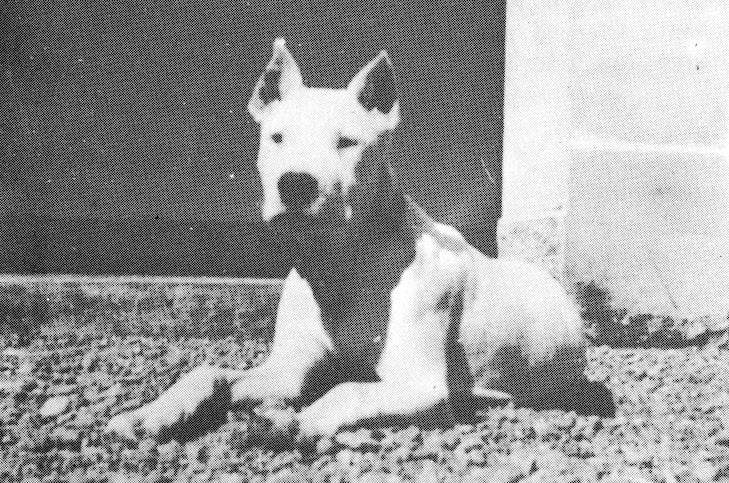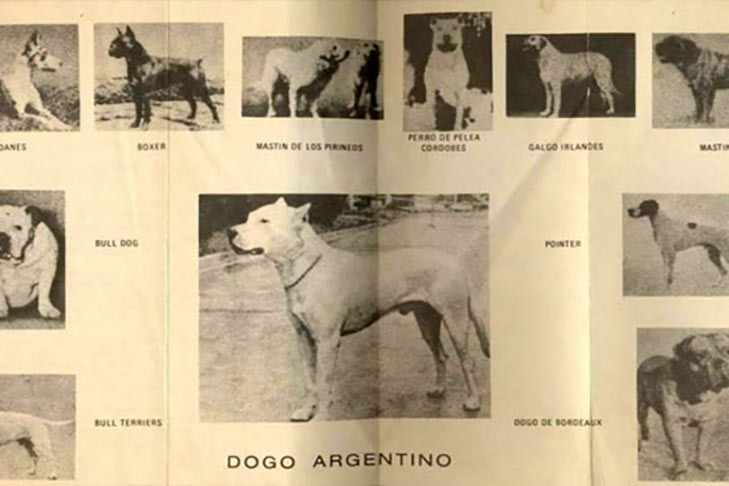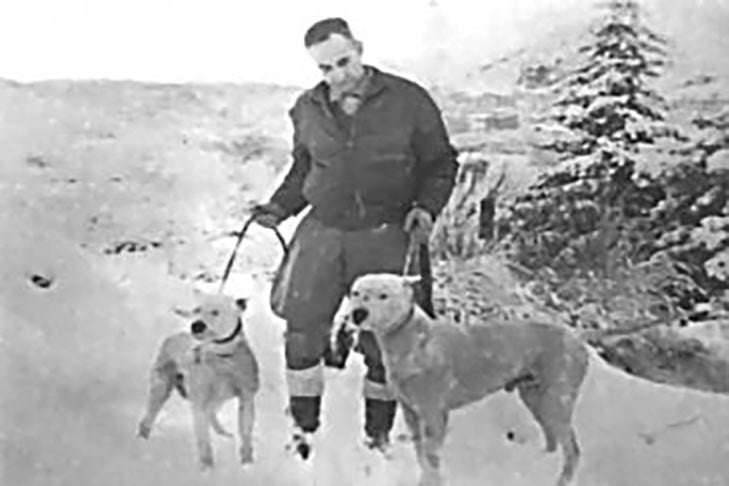
Argentina is the birthplace of the tango, an explosively intense dance that rivets anyone who watches it. So it’s perhaps fitting that this South American country, forged by the intersection of Old World colonialism and the rusticity of the untamed pampas, would be home to a dog breed whose own intensity of character and dramatic aesthetics are equally attention-grabbing.
Unlike many breeds that evolved organically in a time and place to perform a certain function, the Dogo Argentino was the result of a deliberate act of creation. The breed was willed into being in the mid-1920s by a teenager who not only had a vision of the ultimate big-game hunting dog bounding across Argentina’s wide-ranging grasslands in pursuit of wild boar and puma, but also, coming from a family of privilege, had the resources to accomplish this in a relatively compressed period of time.
Steady, Brave, and Powerful
Dr. Antonio Nores Martinez was, like his father before him, a physician, as well as a professor. But he began his adventure with the Dogo Argentino at 18 years old, an age when most young men are obsessed with things other than creating a dog with a stark white coat and an equally intense ferocity.
It’s fortunate that Dr. Nores Martinez proceeded with such laser focus, as the foundation of his new breed – the Viejo Perro de Pelea Cordobés, or old fighting dog of Cordoba – was at that point teetering on the brink of extinction. But before that long-ago dog faded into the history books, Dr. Nores Martinez transformed it into the impressive white-coated athlete and hunter that we know today.
As its name suggests, the old fighting dog of Cordoba was a master of the fighting pits, developed from generations of Old World mastiff-type dogs. The Cordoba dog was also a talented hunter, with one deal-breaking drawback – its understandably intense dog aggression.
A century ago in Argentina, sportsmen brought down their game without firearms, using only a knife. To take part in this almost medieval exercise, a dog needed to not only be unerringly steady and brave, but also athletic enough to track his prey, agile enough to dodge tusk and claw, and powerful enough to hold his own in a fight to the death.

Creating the Dogo Argentino
Together with his younger brother Agustín, Dr. Nores Martinez crossed various breeds with Cordoba’s unrelenting fighting dog in an effort to give it the missing traits that would make it a peerless hunter and effective pack dog. The Pointer enhanced scenting ability, while the harlequin Great Dane added height. The Bull Terrier contributed the white coat that has become the breed’s hallmark – as well as the occasional “pirate” patch that is sometimes present over one of the eyes (the only place where a Dogo can have an allowable black patch). Yet-another white breed, the rare Pyrenean Mastiff, imparted a steady, calm temperament, while the Boxer gave additional tractability as well as agility. The need for powerful jaws occasioned crosses to Bulldogs.
In 1928, several years after he started breeding, Dr. Nores Martinez wrote the first Dogo Argentino breed standard, accompanied by his drawings of the ideal Dogo. Some two decades later, the breed was popular enough to have this description published in a national magazine, and Dr. Nores Martinez organized a demonstration to show off the dog’s gladiatorial capabilities, pitting his Dogo against a boar and a puma. Of the three, only the dog survived.
Unfortunately, Dr. Nores Martinez himself did not live long enough to see his breed recognized on the international stage. Out bird-hunting without his Dogo in 1956, he was murdered, along with a friend, presumably in a botched burglary.
In the aftermath of Dr. Nores Martinez’s death, his brother Agustín was jailed as a political prisoner, and the kennel disbanded. Somehow, after his release, the younger Nores Martinez tracked down some of the original dogs, and restarted the breeding program, intending to see his brother’s dream come to complete fruition. A prominent attorney, he was named Argentina’s ambassador to Canada, a high-visibility post that permitted him to travel the world, publicizing the Dogo Argentino along the way.

Today’s Dogo Argentino
In 1964, the breed was nationally recognized by the Argentine Kennel Club; the Federación Cynologique Internationale – the global organization governing dog shows in South America, Europe, and most of the non-English-speaking world – followed suit in 1973.
While Dogos have enjoyed an abiding – and understandable – popularity among American hog hunters in the West and South, the breed did not receive full recognition from the American Kennel Club until earlier this year. As a result, Americans have yet to see the sinewy and powerful Dogo Argentino trot across the screen during one of the nation’s popular televised dog shows. But that will happen soon enough.
And when it does, those who know what it’s like to be protected by a Dogo will need to return the favor.
As is fitting in a dog whose calling card is his undiluted loyalty, the Dogo Argentino has an equally ardent following of fanciers who cannot imagine owning any other breed. Knowing that the fire of his Cordoban ancestor has not been completely extinguished in the Dogo, they are careful to remind that this breed is not for everyone. The Dogo Argentino requires a strong owner, intense socialization, and a clear understanding of his steely-willed nature.
But for those who are up to the challenge – to say nothing of the responsibility – the Dogo Argentino will reward them with a devotion so fierce, many will wonder if they themselves were ever deserving of it.

